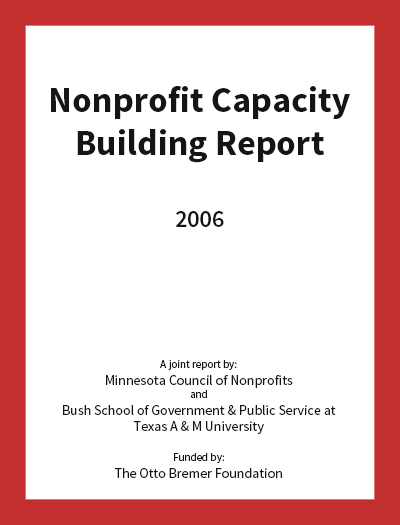A collaboration between Texas A&M University and the Minnesota Council of Nonprofits, under the supervision of Dr. Angela Bies
Research has identified explosive growth in the nonprofit sector and an increased interest in evaluating and improving nonprofit performance through organizational capacity building. The growing emphasis on capacity-building services for nonprofits nationwide has resulted in the need for better information about support services for the sector. Considering the burgeoning role of capacity building in nonprofit operations, it is important to understand more about the industry that provides support and resources to nonprofits, including in the Minnesota community. This study of the nonprofit capacity-building industry in Minnesota is a result of research conducted by graduate students from the Bush School of Government and Public Service at Texas A&M University under the supervision of Dr. Angela Bies. Five students coordinated and conducted the research and analysis for this report from September 2006 through April 2007. (Information about the authors can be found in Appendix E of the report.)
Funding for the study came from the Otto Bremer Foundation.

The primary research objective was to replicate two recent studies on nonprofit capacity building – a Pittsburgh-based study and a study focused in Central-Texas. Both, Millesen and Bies’ 2004 report for the Forbes Funds, An Analysis of the Pittsburgh Region’s Capacity-Building ‘Industry’ (hereinafter referred to as the Pittsburgh study) and Bies and Rehnborg’s 2005 Report for United Way Capital Area and the Texas Nonprofit Management Assistance Program, An Analysis of the Nonprofit and Volunteer Capacity-Building Industries in Central Texas (hereinafter referred to as the Texas study), were significant to the study’s research design.
In line with the two previous reports, thecore research purpose was to describe and analyze the quantity and quality of capacity-building services provided to nonprofit organizations within Minnesota. The Pittsburgh and Texas studies provided a template for the “multi-method research process, designed to capture both the diversity of the sector and the continuum of capacity-building services offered to nonprofit organizations” (Millesen & Bies, 2004, I). The research, however, diverged from the prior studies in some areas. The Texas replication added to the area of study set forth from Pittsburgh by conducting a specific examination of volunteer management capacity and disaster response in the wake of Hurricanes Katrina and Rita. In this study we address nonprofit advocacy and public policy capacity in addition to capacity-building issues covered in our foundational research questions.